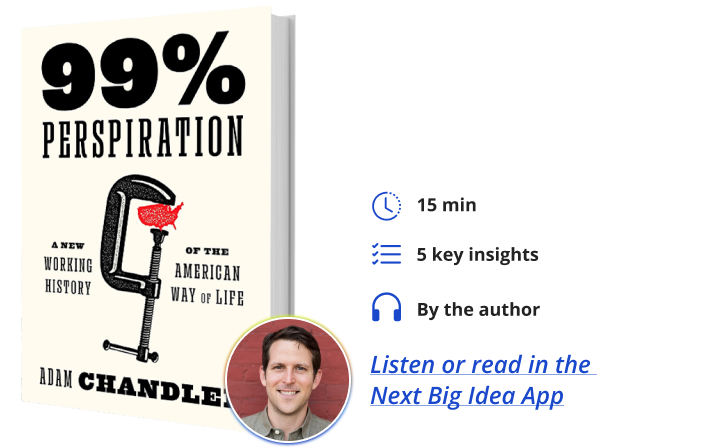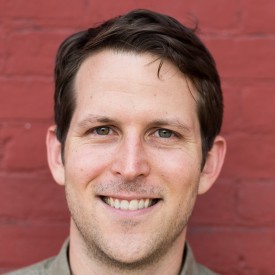Adam Chandler is a journalist. He was formerly a staff writer at The Atlantic and his work has appeared in the New York Times, The Wall Street Journal, The Washington Post, WIRED, and Vox, among many other publications. He is a recurring guest on The History Channel’s The Food That Built America and regularly appears across television and radio, such as on CBS and NPR.
What’s the big idea?
American work standards are damaging the well-being of employees, as well as the success of companies. Myths about achievement, productivity, and equality are clouding our collective reasoning about what leads to a long and fulfilling life. Fixing job culture has the power to fix America’s social crisis.
Below, Adam shares five key insights from his new book, 99% Perspiration: A New Working History of the American Way of Life. Listen to the audio version—read by Adam himself—in the Next Big Idea App.

1. The American Abracadabra.
The Bootstraps Myth—the belief that anyone can succeed with hard work and a little moxie—is a core tenet of American life. It’s visible in culture, policy, and civics. But there’s a dark side to this ideal. If you fail to get ahead, it means that you didn’t try hard enough. I call this The American Abracadabra.
The danger of the abracadabra is that it turns success or failure into a matter of individual character, rather than prompting us to collectively confront the obstacles that have made achieving success so much harder in recent years. To understand what prevents Americans from a prosperous and stable life, we might examine the costs of housing, healthcare, childcare, and college in the U.S. A recent study by the Brookings Institution revealed that an astonishing 44 percent of Americans hold jobs that qualify as low-wage.
2. Everyone benefits from time off, especially employers.
Generous time-off policies in the U.S. have long been looked upon with suspicion by bottom-line-minded employers, particularly when compared to America’s peer nations. One result is that American workers log more work hours than nearly all other industrialized countries. They also tend to eschew the breaks to which they’re entitled. According to Pew, roughly half of all U.S. workers avoid using their allotted time off out of fear of seeming disloyal, replaceable, or burdening their co-workers. Interestingly, it’s higher earners in particular who are the most reluctant to use all their paid time off. Studies have found that at companies with unlimited time-off policies, workers take even fewer days off.
“Employees who take time off are not only happier and healthier, but also more productive, more creative, and more loyal.”
There’s a strong case for employers to encourage workers to step away from their desks and take time off. Employees who take time off are not only happier and healthier, but also more productive, more creative, and more loyal. Another big piece of this equation is the high cost of turnover for companies in training and replacing workers, as well as in lost morale. Using data from the Bureau of Labor Statistics in 2019, Gallup put a conservative price tag of $1 trillion on the replacement cost of employees who leave their jobs in the U.S. each year, estimating that “The cost of replacing an individual employee can range from one-half to two times the employee’s annual salary.”
3. The American work obsession is a civic and social crisis.
Americans disproportionately define themselves by their jobs. In a recent Pew survey, an astounding 71 percent of Americans listed having a job or career they enjoyed as the top measure of what makes for a fulfilling life, more than close friendships, having children, or marriage.
Even as we put more of ourselves into work—whether it’s how we spend our time, construct social circles, or identify ourselves—work does not love us back. A 2023 economic opportunity poll by Gallup found that 39 percent of Americans believed that they were failing to get ahead despite working hard. That figure was 23 percent in 2002. Work’s failure to get us where we want to be is driving resentment, distrust of institutions, xenophobia, and extremism.
4. Immigration is critical to the strength and durability of the American economy.
In recent years, immigration, legal or otherwise, has been the focus of populist ire and the centerpiece of political campaigns. What they often leave out is that immigrants are 80 percent more likely to start a business than native-born Americans, whether it’s a mom-and-pop outfit like a restaurant or gas station, or a huge company like Google, Zoom, or Duolingo. On average, immigrant-founded businesses hire more workers than others.
“Immigrants are 80 percent more likely to start a business than native-born Americans.”
When it comes to government benefits, immigrants pay $1.38 in taxes for every dollar of government benefits they use. Lastly, undocumented immigrants paid $96.7 billion in federal, state, and local taxes in 2022, far more than many loophole-savvy billionaires or companies on the Fortune 500.
5. American income inequality isn’t just about money.
Income inequality has reached dangerous levels. The effect of these disparities has had strange consequences. Between 1970 and 2009, Stanford researchers estimated that “the share of families living in middle-income neighborhoods dropped from 65 percent to 44 percent.” In other words, higher-income households wended their way to wealthier neighborhoods while low-income households went to poorer ones. Back in 1980, you could live in a city with a high level of income inequality, and it didn’t necessarily map geographically. The kid of a doctor and the kid of a dockworker were more likely to play ball in the same street and go to the same school.
But that’s no longer the case. These divergences influence everything in a neighborhood, from crime rate, school quality, social mobility, and its stock of good-paying jobs to the presence of environmental hazards, the likelihood of developing chronic health conditions, and the life expectancies of both old and young. Fortunately, countless people at every level of society are working on bold initiatives to make communities stronger, safer, healthier, and happier.
To listen to the audio version read by author Adam Chandler, download the Next Big Idea App today:





























